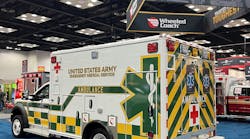Holes in the ozone, energy conservation, global warming, rising sea levels, green living, green building, global calamity on a scale never before seen by man. Depending on which media pundit you listen to, life as we know it should be coming to an end soon. Right, wrong or indifferent, the call for environmental responsibility and energy-efficient living has had an impact on the way many homes and businesses are constructed and this in turn has an impact on your thermal imaging operations. Insulation in the walls, floors and ceilings; low-E window glass, radiant floor heating, skylights and other steps taken to limit the transfer of heat into or out of a structure have all had an impact on thermal imaging operations.
• Insulation — Insulation comes in different types, including rolled, blown, sprayed, rigid and reflective, each with insulative values called R-values. The higher the R-value, the better the insulation. Each behaves differently when evaluated by a thermal imager. If you have become used to using your thermal imager for building size-up, then you know how valuable it can be in revealing areas of natural heat accumulation such as walls, windows and roofs; however, the better insulated a home, the more difficult it is to notice such heat signatures. The simplest concept is that the better an object is at keeping heat in (blanket, thermos, winter coat), the harder it is to view with a thermal imager. Most commonly, residential walls are filled with rolled insulation, which is typically a fiberglass product with excellent R-value and good resistance to flame. However, newer homes are constructed with sprayed insulation and the walls of older homes may be filled with blown insulation.
Sprayed insulation is an expanding liquid sprayed onto bare-stud walls with a paint-sprayer-style device and rapidly expands to fill the void. It is similar to the foam used inside your fire helmet and to protect the electronics inside your thermal imager. Sprayed foam is very efficient, since typically there are no voids in the application and the foam has superior R-values. The problem is that some foam is not as resistive to flame and smoldering fires can develop inside the insulation itself and may not be visible with a thermal imager. For this reason, it is generally best to cut the foam out of the walls in sections during overhaul to make sure that there are no lingering issues.
Blown insulation is common in attics and walls of older homes since it can be added after construction through small holes drilled between the studs. Blown insulation is usually less insulative than other methods and it settles over time, so re-application is usually required to maintain its R-values. Blown insulation presents two issues for thermal imaging. The first is that normal settling within the walls can make a structure appear to have a false heat signature near the tops of the walls. As the insulation settles, more heat escapes near the top of the walls. From the outside of the structure, this can give the distinct appearance of a high-heat condition on the inside that simply does not exist. The second hazard is, particularly in attic fires, the possibility to have a smoldering fire beneath the insulation, which is impossible to detect with the thermal imager. If you have ever overhauled a smoldering insulation fire in the attic, then you know what I mean. Wetting it down usually does not work and evaluation with a thermal imager is generally pointless. Removal is always the best option.
• Low-E glass — The "E" in Low-E stands for emissivity. Recall that a thermal imager bases everything it knows on emissivity. Generally speaking, emissivity refers to the rate at which a surface emits thermal energy. Low-E then is designed to limit the very thing that your thermal imager is attempting to look for. Low-E glass is generally constructed using multiple layers of specially coated reflective glass with an inert insulative gas in between. While a thermal imager cannot see through glass of any type, it can detect warm glass in standard windows; however, Low-E glass makes this process difficult during size-up.
• Skylights — Skylights are becoming more popular since they are a source of natural light and reduce the dependency of the structure on electricity for interior lighting. These skylights are typically difficult to assess with a thermal imager because they are often reflective on the outside of the glass as well as the interior of the shaft. Skylights are easily located inside a structure fire with a thermal imager and often serve as excellent points of interior ventilation given their location and relative ease of dislodging with a pike pole.
As in all other facets of firefighting, things change over time. Low-E or green living is likely to grow in the future — if not out of apocalyptic environmental concern, then for the simple fact of reduced electricity bills. Even fire stations are being built green with Scottsdale, AZ, recently achieving a highly coveted Leadership in Energy and Environmental Design (LEED) Platinum award from the U.S. Green Building Council. As a firefighter and thermal imaging user, you simply need to be aware of the implications so that you remain prepared to handle whatever it is that life throws at you.
BRAD HARVEY is the Thermal Imaging Product Manager at Bullard. He is a veteran of public safety as a firefighter, police officer and paramedic and is certified through the Law Enforcement Thermographers' Association (LETA) as a thermal imaging instructor. Harvey has worked as a high-angle rescue instructor and is a certified rescue technician and fire instructor. If you have questions about thermal imaging, you may e-mail him at [email protected].





